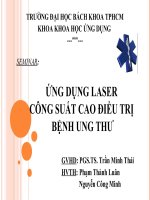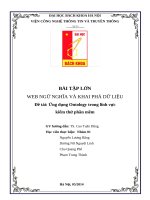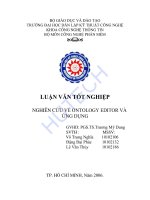Ontology seminar Ứng dụng ontology
Bạn đang xem bản rút gọn của tài liệu. Xem và tải ngay bản đầy đủ của tài liệu tại đây (1.06 MB, 95 trang )
Ontologies and Much More
Presented by Osnat Minz
July 2006
1
Agenda
Introduction to semantic web
Ontology
RDF , RDFs ,OWL
Introduction to semantic web services
Very Brief MDA Introduction
Potential Uses of the Semantic Web in Systems and
Software Engineering
2
Summarizing the Problem:
Computers don’t understand Meaning
“My
mouse is broken. I
need a new one…”
3
The Semantic Web Vision
“…
the idea of having data on the Web
defined and linked in a way that it
can be used by machines not just for
display purposes ,but for automation,
integration and reuse of data across
various applications”
/>
4
The Semantic Web
"The Semantic Web is an extension of the current web in
which information is given well-defined meaning, better
enabling computers and people to work in cooperation."
-- Tim Berners-Lee
“the wedding cake”
5
Semantic Web – New Users
Semantic
Web and
Beyond
Creators
Users
Semantic Web
content
applications
agents
Semantic
Annotations
Ontologies
Logical Support
Languages
Tools
Applications /
Services
Semantic
Web
WWW
and
Beyond
Creators
Users
Web content
6
Where we are Today:
The Syntactic Web
[Hendler & Miller 02]
7
The Syntactic Web is…
A hypermedia, a digital library
A database, an application platform
A common portal to applications accessible through
web pages, and presenting their results as web pages
A platform for multimedia
A library of documents called (web pages)
interconnected by a hypermedia of links
BBC Radio 4 anywhere in the world!
trailers!
Terminator 3
A naming scheme
Unique identity for those documents
A place where computers do the presentation (easy)
and people do the linking and interpreting (hard).
Why not get computers to do more of the hard
work?
[Goble 03]
8
Impossible (?)
Using the Syntactic Web…
Complex queries involving background knowledge
e.g., Barn Owl
Locating information in data, repositories
Travel enquiries
Prices of goods and services
Results of human genome experiments
Finding and using “web services”
Find information about “animals that use sonar but are
not either bats or dolphins”
Visualise surface interactions between two proteins
Delegating complex tasks to web “agents”
Book me a holiday next weekend somewhere warm, not
too far away, and where they speak French or English
9
What is the Problem?
Consider a typical web page:
Markup consists of:
rendering
information
(e.g., font size
and colour)
Hyper-links to
related content
Semantic content
is accessible to
humans but not
(easily) to
computers…
10
What information can we see…
WWW2002
The eleventh international world wide web conference
Sheraton waikiki hotel
Honolulu, hawaii, USA
7-11 may 2002
1 location 5 days learn interact
Registered participants coming from
australia, canada, chile denmark, france, germany, ghana,
hong kong, india, ireland, italy, japan, malta, new zealand,
the netherlands, norway, singapore, switzerland, the
united kingdom, the united states, vietnam, zaire
Register now
On the 7th May Honolulu will provide the backdrop of the
eleventh international world wide web conference. This
prestigious event …
Speakers confirmed
Tim berners-lee
Tim is the well known inventor of the Web, …
Ian Foster
Ian is the pioneer of the Grid, the next generation internet …
11
What information can a machine see…
…
…
…
12
Solution:
XML markup with “meaningful” tags?
<name>
</name>
<location>
</location>
<date> </date>
<slogan> </slogan>
</participants>
<introduction>
…
</introduction>
<speaker> </speaker>
<bio> </bio>…
13
But What About…
<conf>
</conf>
</place>
<date> </date>
<slogan> </slogan>
</participants>
<introduction>
…
</introduction>
<speaker> </speaker>
<bio> …
14
Machine sees…
< >
>
< >
</ >
< > </ >
< > </ >
< >
>
< >
…
</ >
< > </ >
< > </ >
15
Need to Add “Semantics”
Use
Ontologies to specify meaning of annotations
Ontologies provide a vocabulary of terms
New terms can be formed by combining
existing ones
Meaning (semantics) of such terms is
formally specified
Can also specify relationships between terms
in multiple ontologies
16
Ontology: Origins and History
Ontology in Philosophy
A philosophical discipline - a branch of
philosophy that deals with the nature and the
organisation of reality
Science of Being (Aristotle, Metaphysics, IV, 1)
Tries to answer the questions:
What
characterizes being?
Eventually, what is being?
17
Ontology in Linguistics
Concept
Relates to
activates
Form
“Tank“
[Ogden, Richards, 1923]
Stands for
Referent
?
18
Ontology Definition
unambiguous
terminology definitions
conceptual model
of a domain
(ontological theory)
Formal, explicit specification of a shared conceptualization
[Gruber93]
machine-readability
with computational
semantics
commonly accepted
understanding
19
Ontology in Computer Science
An ontology is an engineering
artifact:
It is constituted by a specific vocabulary
used to describe a certain reality, plus
a set of explicit assumptions regarding the
intended meaning of the vocabulary.
Thus, an ontology describes a formal
specification of a certain domain:
Shared understanding of a domain of interest
Formal and machine manipulable model of a
domain of interest
20
Structure of an Ontology
Ontologies typically have two distinct components:
Names for important concepts in the domain
Elephant is a concept whose members are a kind of
animal
Herbivore is a concept whose members are exactly
those animals who eat only plants or parts of plants
Adult_Elephant is a concept whose members are
exactly those elephants whose age is greater than 20
years
Background knowledge/constraints on the domain
Adult_Elephants weigh at least 2,000 kg
All Elephants are either African_Elephants or
Indian_Elephants
No individual can be both a Herbivore and a
Carnivore
21
Ontology Example
Concept
conceptual entity of the
domain
Attribute
property of a concept
name
relationship between
concepts or properties
Axiom
Person
student
nr.
Relation
research
field
isA – hierarchy (taxonomy)
Student
Professor
attends
coherent description
between Concepts /
Properties / Relations via
logical expressions
holds
Lecture
lecture
nr.
holds(Professor, Lecture) ⇒ Lecture.topic ∈
topic
22
Ontology Elements
Concepts (classes) + their hierarchy
Concept properties (slots/attributes)
Property restrictions (type, cardinality, domain)
Relations between concepts (disjoint, equality)
Instances
23
How to build an ontology?
Steps:
determine domain and scope
enumerate important terms
define classes and class hierarchies
define slots
define slot restrictions (cardinality,
value-type
24
Step 1: Determine Domain and Scope
Domain: geography
Application: route planning agent
Possible questions:
Distance between two cities?
What sort of connections exist between two cities?
In which country is a city?
How many borders are crossed?
25









